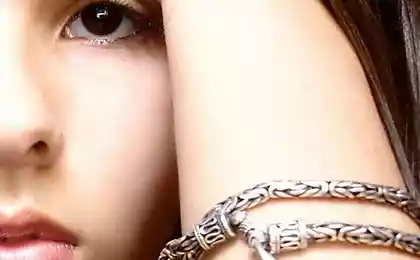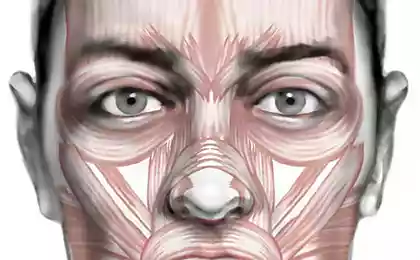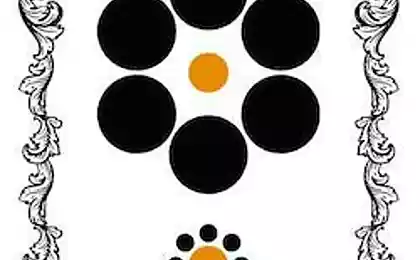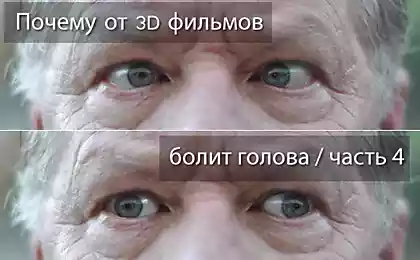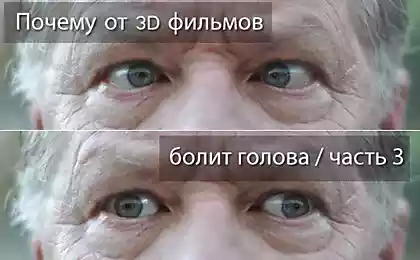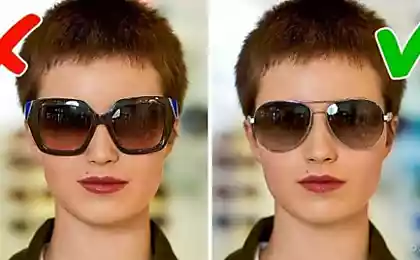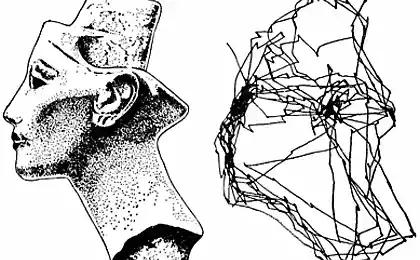541
Everyday illusions — why we see faces of inanimate objects
Twelve million nine hundred twenty six thousand two hundred eighty one
It often happens that you look at your food, and she looks at you. Somehow Diana Dayzer made myself toast with cheese and was shocked. "I was just about to bite him, when he saw the woman's face. She looked at me, — Diana told the Chicago Tribune. — It gave me the creeps".History Gaiser became known, began to attract more and more attention, and eventually a casino paid her 28 million dollars for the right to put the toast on his display. Many people soft rounded features and a peaceful expression "imprinted" on it women are like the virgin Mary. Personally, I always thought that wavy hair, parted lips and thick lashes rather evoke a more modern idol.
What would Madonna you remembered seeing the woman on the toast, you can assume that she was in good company. The image of Jesus is also seen on a piece of bread, and tacos, empanada and a banana peel, while the site BuzzFeed recently posted photos of peppers, reminiscent of the faces of British politicians.
"If someone says they saw Jesus on a sandwich, you'd think this man's gone mad, says Kang Lee, a specialist from the University of Toronto, Canada. — However, this phenomenon is quite common. We are programmed to see faces on every corner in the surrounding visual world." Lee proved that such an experience can be not only divine intervention but also the result of the influence that our imagination affects perception. Of course, after his explanation, you have the risk of forever losing the ability to believe their eyes.
"If someone says they saw Jesus on a sandwich, you'd think this man was crazy. However, this phenomenon often"
This phenomenon is called "pareidolia" and is found very often. Leonardo da Vinci wrote about the images of people who have seen among the natural markings on the stone walls, and believed that they help you to find inspiration. The Bank of Canada in 1950-ies was forced to withdraw a series of banknotes because a grinning devil, who has found among the curls on the head of the Royal (although personally I've never seen on the head of Her Majesty's nary a hint of horns). And spacecraft Viking I expedition found on Mars distorted face, carved in stone among the rocks.
Today to share his visions with others has become easier thanks to social networks. Just look for the hashtag #iseefaces. You will see a wise dwarf who was hidden among the folds of tree bark:
...the trash, which welcomes you with a joyful smile:
...a few vicious pretzels:
...and kettle are applying for the role of Hannibal Lecter.
However, the worst case probably occurred with the urologist Gregory Roberts and his patient from Kingston, Canada. Imagine the shock they experienced when, during the ultrasound examination of the testicles saw this Crescent-shaped face, which was staring at them...
The reality is that if you started to see the faces of subjects, who look at you, you'll notice them everywhere. Some of these objects definitely have similarities with smiles. But sometimes strange creatures can jump out at us from unexpected places. In one study, If the participants of the experiment showed gray patterns similar to what we see on the TV screen when the antenna is not working. Getting the subtle hint, these people suddenly began to say that you see among the patterns of the face, and "watched" it for 34% of the time. All of the contours that were present in the images were extremely blurry — and yet somehow the brain had managed to assemble them in the midst of the facial image. "It appears that the emergence of this phenomenon is easy enough to provoke," says Lee.
However, we prefer to think that our pupils always honestly report that is before us, and the retina receives an imperfect evading us, but a real image, which is then forwarded to the brain. If I am sure that this "downward data processing" and leads to pareidolia.
One of the ways that helps the brain navigate in the prevailing confusion, is the creation of predictions about what's going to appear in sight. It is based on our experience and is able quietly to project these expectations on what we see. It helps to put all the details in a clear picture even if the objects are hard to see, for example, due to fog or in the dark. However, this same mechanism makes our vision more subjective than one would assume, because we really see what we want.
To test his hypothesis, Whether the recording the readings of electrical brain activity of each participant during the experiment. As expected, he found increased activity in striate cortex (area of the brain engaged in primary processing of visual information) in a time when people began to pay attention to the color and outline images. But, in addition, Lee saw that the activity broke out in the frontal and occipital areas, which are responsible for higher cognitive functions, in particular planning and memory. This happened as soon as the subjects began to see the illusory face. This jump in activity probably suggests that in this process play the role of expectations and experience, as predicted in lie theory. This, in turn, may be associated with the operation of the right fusiform gyrus, which calculates whether the object recognized as a person. Her job, obviously, and creates an eerie feeling that we are looking at a creature that is able to think and feel. "If such an activity occurs, we know what people really "see" the face," says Lee.
This may explain why the illusory appearance of individuals provokes the same subconscious reactions which arise when you look at a real person. Last year, for example, a group of Japanese researchers found that we follow the "look" of such persons is exactly the same as for the opinion of real people. In other words, if we see that we puzzled glances house, we can experience a strong desire to find out what made him so amazing.
Experiments meant to create a map of brain regions involved in the recognition of the illusory persons, but still did not answer the question of why we see them. One of the reasons may be the fact that every day we are faced with a lot of parties and expect to meet them everywhere. "Since our childhood, they become a stimulus we encounter most often," explains Lee. Perhaps there are deeper evolutionary reasons why we are particularly inclined to see it person. In matters of the survival of the people so dependent on others — no matter whether he needs their help or, on the contrary, fears of their aggression, that he simply needed to be able to react quickly and well to understand the motives of human actions. So our brain probably just created in order to notice other people wherever possible. If we happen to make a mistake and see a face in the folds of tree bark, it is better than not to see the enemy, hiding in the bushes.
"In an attempt to make their fears a sense, we begin to personify them, inhabiting the world of gods and demons"
According to other researchers, if you look at this mechanism are more speculative, may explain human spirituality. The idea is that the brain is programmed to understanding the actions and motivations of other people, trying to find the intent of a human, all around, whether rain, or plague of terrifying us the abstract concept of death. In an attempt to make their fears a sense, we begin to personify them, inhabiting the world of gods and demons. Surprisingly, Tapani Riekki and other experts from the University of Helsinki, Finland, found that religious people more than atheists, you can see faces in fuzzy images. However, regardless of, is it true such a theory, the strength of our expectations may, at least, to explain why some see the piece of bread the mother of God, and the other Queen of pop. Or take another snapshot. Do you see Christ?...
And yet, probably the most common form pareidolia in the Western world is in the habit of seeing faces in cars. Sonia Windhager from the University of Vienna, for example, specifically went to the countryside in Ethiopia, to find out, see if the locals the same. Interviewing people on the roads and in the eatery, she faced an unexpected reaction. "They thought I was a little crazy," says Sonia. And yet, despite the fact that the inhabitants of the Ethiopian villages't watched cartoons like "Cars", they quickly understood the purpose of the study and began to evaluate images almost as much as the Europeans. For example, a car with a large windscreen, round headlights and a small grille and in Europe and in Africa are commonly perceived as "young" and "girls":
...while the flat headlights and the large, angular case is associated with adulthood and masculine traits.
According to Sony Windhager, this means that our brain is programmed to read the most basic biological information — age and gender — from any object vaguely resembling a face. This fact, from her point of view, suggests that pareidolia is an evolutionary origin. "Curious how the modern environment makes us use the perception of reality of such an ancient mechanism," says Sonia.
Other studies Windhager showed that consumers tend to choose the "power" of the machine, and manufacturers do use this trend. For example, in 2006, the Wall Street Journal said that the "cute" cars like the legendary Volkswagen Beetle today began to sell worse — perhaps due to the fact that their owners feel fear and embarrassment before the face of sports cars, whose number is every year increasing. That's why designers often create cars that look more dominant. Dodge Charger, for example, were fitted with narrow sloping headlamps, which gave him a menacing look and create the impression that he stares at other cars, will drive it into the paint. "Lights, seem able to make eye contact just as the human eye, I'm sure the Chrysler designer Ralph Gills. — Bad person — that's what we aspire to." Windhager, in turn, asks whether the illusion of eye contact to affect safety on the roads. For example, we may get into trouble if the "expression" of the machine subconsciously decide that it is reasonable. "The children may seem as if the machine sees them, if they go across the path, — so they will not stop the transition," says Sonia. A meeting with cars with more threatening "expression" can cause other drivers anxiety or aggression.
Such psychological effects can manifest in all areas of our lives. Various studies have shown that a simple image of a pair of eyes staring at close range, makes people behave more honest, and in some countries this technique "pesky surveillance" provided a 60% reduction in bike thefts. I wonder if "face" painted on the homes and secretly watching the passers-by, affect the frequency of thefts...
Surprisingly, a motley group of characters, and the pictures people post on the social network with the hashtag #iseefaces, in fact, secretly controls our behavior. Perhaps today we do not tend to inhabit the nature spirits, just as our ancestors did, but still let those phantom creatures into our homes, cars and Twitter. After all, in the end, they can transform the most ugly and soulless places in the paintings, full of beauty and humor.
Source: theoryandpractice.ru
It often happens that you look at your food, and she looks at you. Somehow Diana Dayzer made myself toast with cheese and was shocked. "I was just about to bite him, when he saw the woman's face. She looked at me, — Diana told the Chicago Tribune. — It gave me the creeps".History Gaiser became known, began to attract more and more attention, and eventually a casino paid her 28 million dollars for the right to put the toast on his display. Many people soft rounded features and a peaceful expression "imprinted" on it women are like the virgin Mary. Personally, I always thought that wavy hair, parted lips and thick lashes rather evoke a more modern idol.
What would Madonna you remembered seeing the woman on the toast, you can assume that she was in good company. The image of Jesus is also seen on a piece of bread, and tacos, empanada and a banana peel, while the site BuzzFeed recently posted photos of peppers, reminiscent of the faces of British politicians.
"If someone says they saw Jesus on a sandwich, you'd think this man's gone mad, says Kang Lee, a specialist from the University of Toronto, Canada. — However, this phenomenon is quite common. We are programmed to see faces on every corner in the surrounding visual world." Lee proved that such an experience can be not only divine intervention but also the result of the influence that our imagination affects perception. Of course, after his explanation, you have the risk of forever losing the ability to believe their eyes.
"If someone says they saw Jesus on a sandwich, you'd think this man was crazy. However, this phenomenon often"
This phenomenon is called "pareidolia" and is found very often. Leonardo da Vinci wrote about the images of people who have seen among the natural markings on the stone walls, and believed that they help you to find inspiration. The Bank of Canada in 1950-ies was forced to withdraw a series of banknotes because a grinning devil, who has found among the curls on the head of the Royal (although personally I've never seen on the head of Her Majesty's nary a hint of horns). And spacecraft Viking I expedition found on Mars distorted face, carved in stone among the rocks.
Today to share his visions with others has become easier thanks to social networks. Just look for the hashtag #iseefaces. You will see a wise dwarf who was hidden among the folds of tree bark:
...the trash, which welcomes you with a joyful smile:
...a few vicious pretzels:
...and kettle are applying for the role of Hannibal Lecter.
However, the worst case probably occurred with the urologist Gregory Roberts and his patient from Kingston, Canada. Imagine the shock they experienced when, during the ultrasound examination of the testicles saw this Crescent-shaped face, which was staring at them...
The reality is that if you started to see the faces of subjects, who look at you, you'll notice them everywhere. Some of these objects definitely have similarities with smiles. But sometimes strange creatures can jump out at us from unexpected places. In one study, If the participants of the experiment showed gray patterns similar to what we see on the TV screen when the antenna is not working. Getting the subtle hint, these people suddenly began to say that you see among the patterns of the face, and "watched" it for 34% of the time. All of the contours that were present in the images were extremely blurry — and yet somehow the brain had managed to assemble them in the midst of the facial image. "It appears that the emergence of this phenomenon is easy enough to provoke," says Lee.
However, we prefer to think that our pupils always honestly report that is before us, and the retina receives an imperfect evading us, but a real image, which is then forwarded to the brain. If I am sure that this "downward data processing" and leads to pareidolia.
One of the ways that helps the brain navigate in the prevailing confusion, is the creation of predictions about what's going to appear in sight. It is based on our experience and is able quietly to project these expectations on what we see. It helps to put all the details in a clear picture even if the objects are hard to see, for example, due to fog or in the dark. However, this same mechanism makes our vision more subjective than one would assume, because we really see what we want.
To test his hypothesis, Whether the recording the readings of electrical brain activity of each participant during the experiment. As expected, he found increased activity in striate cortex (area of the brain engaged in primary processing of visual information) in a time when people began to pay attention to the color and outline images. But, in addition, Lee saw that the activity broke out in the frontal and occipital areas, which are responsible for higher cognitive functions, in particular planning and memory. This happened as soon as the subjects began to see the illusory face. This jump in activity probably suggests that in this process play the role of expectations and experience, as predicted in lie theory. This, in turn, may be associated with the operation of the right fusiform gyrus, which calculates whether the object recognized as a person. Her job, obviously, and creates an eerie feeling that we are looking at a creature that is able to think and feel. "If such an activity occurs, we know what people really "see" the face," says Lee.
This may explain why the illusory appearance of individuals provokes the same subconscious reactions which arise when you look at a real person. Last year, for example, a group of Japanese researchers found that we follow the "look" of such persons is exactly the same as for the opinion of real people. In other words, if we see that we puzzled glances house, we can experience a strong desire to find out what made him so amazing.
Experiments meant to create a map of brain regions involved in the recognition of the illusory persons, but still did not answer the question of why we see them. One of the reasons may be the fact that every day we are faced with a lot of parties and expect to meet them everywhere. "Since our childhood, they become a stimulus we encounter most often," explains Lee. Perhaps there are deeper evolutionary reasons why we are particularly inclined to see it person. In matters of the survival of the people so dependent on others — no matter whether he needs their help or, on the contrary, fears of their aggression, that he simply needed to be able to react quickly and well to understand the motives of human actions. So our brain probably just created in order to notice other people wherever possible. If we happen to make a mistake and see a face in the folds of tree bark, it is better than not to see the enemy, hiding in the bushes.
"In an attempt to make their fears a sense, we begin to personify them, inhabiting the world of gods and demons"
According to other researchers, if you look at this mechanism are more speculative, may explain human spirituality. The idea is that the brain is programmed to understanding the actions and motivations of other people, trying to find the intent of a human, all around, whether rain, or plague of terrifying us the abstract concept of death. In an attempt to make their fears a sense, we begin to personify them, inhabiting the world of gods and demons. Surprisingly, Tapani Riekki and other experts from the University of Helsinki, Finland, found that religious people more than atheists, you can see faces in fuzzy images. However, regardless of, is it true such a theory, the strength of our expectations may, at least, to explain why some see the piece of bread the mother of God, and the other Queen of pop. Or take another snapshot. Do you see Christ?...
And yet, probably the most common form pareidolia in the Western world is in the habit of seeing faces in cars. Sonia Windhager from the University of Vienna, for example, specifically went to the countryside in Ethiopia, to find out, see if the locals the same. Interviewing people on the roads and in the eatery, she faced an unexpected reaction. "They thought I was a little crazy," says Sonia. And yet, despite the fact that the inhabitants of the Ethiopian villages't watched cartoons like "Cars", they quickly understood the purpose of the study and began to evaluate images almost as much as the Europeans. For example, a car with a large windscreen, round headlights and a small grille and in Europe and in Africa are commonly perceived as "young" and "girls":
...while the flat headlights and the large, angular case is associated with adulthood and masculine traits.
According to Sony Windhager, this means that our brain is programmed to read the most basic biological information — age and gender — from any object vaguely resembling a face. This fact, from her point of view, suggests that pareidolia is an evolutionary origin. "Curious how the modern environment makes us use the perception of reality of such an ancient mechanism," says Sonia.
Other studies Windhager showed that consumers tend to choose the "power" of the machine, and manufacturers do use this trend. For example, in 2006, the Wall Street Journal said that the "cute" cars like the legendary Volkswagen Beetle today began to sell worse — perhaps due to the fact that their owners feel fear and embarrassment before the face of sports cars, whose number is every year increasing. That's why designers often create cars that look more dominant. Dodge Charger, for example, were fitted with narrow sloping headlamps, which gave him a menacing look and create the impression that he stares at other cars, will drive it into the paint. "Lights, seem able to make eye contact just as the human eye, I'm sure the Chrysler designer Ralph Gills. — Bad person — that's what we aspire to." Windhager, in turn, asks whether the illusion of eye contact to affect safety on the roads. For example, we may get into trouble if the "expression" of the machine subconsciously decide that it is reasonable. "The children may seem as if the machine sees them, if they go across the path, — so they will not stop the transition," says Sonia. A meeting with cars with more threatening "expression" can cause other drivers anxiety or aggression.
Such psychological effects can manifest in all areas of our lives. Various studies have shown that a simple image of a pair of eyes staring at close range, makes people behave more honest, and in some countries this technique "pesky surveillance" provided a 60% reduction in bike thefts. I wonder if "face" painted on the homes and secretly watching the passers-by, affect the frequency of thefts...
Surprisingly, a motley group of characters, and the pictures people post on the social network with the hashtag #iseefaces, in fact, secretly controls our behavior. Perhaps today we do not tend to inhabit the nature spirits, just as our ancestors did, but still let those phantom creatures into our homes, cars and Twitter. After all, in the end, they can transform the most ugly and soulless places in the paintings, full of beauty and humor.
Source: theoryandpractice.ru

